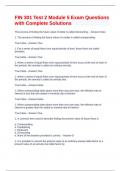Exam (elaborations)
FIN 301 Test 2 Module 5 Exam Questions with Complete Solutions
- Course
- Institution
The process of finding the future value of dollar is called discounting. - Answer-False 1. The process of finding the future value of a dollar is called compounding. True False - Answer-True 1. For a series of equal flows over equal periods of time, those flows are called annuities. Tru...
[Show more]



